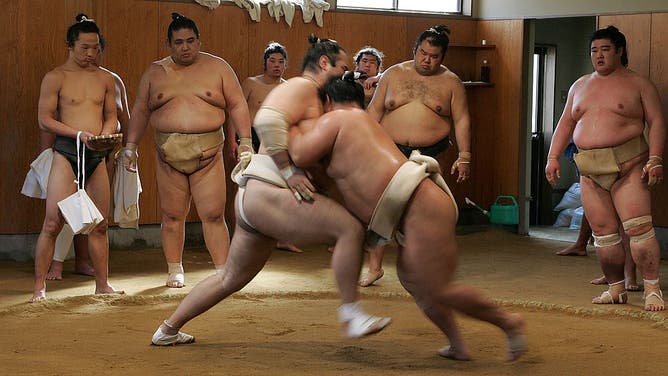My Beloved Japanese Sumo Wrestling Is In Danger Of Being Infiltrated By Soy Boys
The days of watching big beefy Japanese sumo wrestlers wearing diapers slamming into each other are in danger & I'm pretty shook over what I'm reading about a sport I've come to love.
In a rather sobering report this month out of the Times of London, it's being reported that the Japan Sumo Association has dropped a weight and height rule -- 5-foot-6 and 148 pounds (minimum) -- as long as the prospective sumo wrestler can pass a fitness test.
"The change is intended to address a plummet in the numbers of young men seeking to become rikishi, as sumo wrestlers are known," The Times reported.
WHAT?
You're going to allow sumo wrestlers to be less than 148 pounds? If you think I'm watching a bunch of 135-pound soy boys ramming ribs into each other in the middle of the dohyo, the ring, you're absolutely out of your minds, Japan.

Why has it come to this for sumo wrestling?
The Times points to declining birth rates, which has led to a declining population and the lack of children willing to consume the 4,000 calories required to maintain a body ready for war.
In 2015, GQ reported on the diet of Mongolian sumo wrestler Byambajav Ulambayar who was six-foot and 335 pounds. He died in 2020 at age 35.
Ulambayar would consume:
Lunch -- Chanko-nabe (made from broth, mirin, sake and soy sauce) with meatballs, tofu, bok choy, cabbage, carrots, green onions, gobo, and mushroom
Rice
Dinner -- Fried mackerel, Udon noodles, Salad
The demise of sumo wrestling has been predicted before
In 2012, Reuters reported that the sport's popularity was "at an all-time low."
The reason given 11 years ago was that kids were playing baseball, soccer, pay was low and there was a lack of a cool factor. “Sumo is a strict sport,” grand champion Harumafuji told reporters. “Of course there are people who feel there is no need to put themselves through such hardship in an age of convenience.”
A wrestling magazine editor told Reuters that thinner sumo wrestlers would be a solution.
"For example, wrestlers don’t need to be so heavy - thinner is better. This makes for faster wrestlers and more interesting bouts," Eiji Takase, editor-in-chief of “Sumo” magazine, said at the time.
Can wafer-thin soy boys save sumo wrestling?
Sumo historians like to point to the 19th century when shredded (thin) sumo wrestlers were common in the sport. But that was the 19th century. It's the 21st century and our brains are programmed to think of sumo wrestlers as 350-pound giants who look like they could rip huge farts after late-night Taco Bell.
Here's the solution: Put the wafer boys up against the big boys. Let the TV viewer (I watch on English-speaking Japanese news channel NHK -- the next tournament starts November 12) decide if they're ready to see wafer Kenji go up against some 335-pound stud who squats and stares at his prey in the dohyo.
Personally, I don't want to watch some small shredded dude like Takanoyama taking out my beloved big boys. I'll stick with the dudes going tits out.